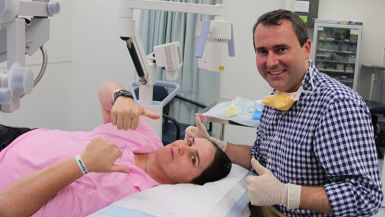RBWH introduces corneal crosslinking
The future is looking much clearer for Jaimee Reynolds as a result of a treatment now being offered by Royal Brisbane and Women’s Hospital Ophthalmology Department.

Thumbs up from patient Jaimee and Dr David Gunn following the RBWH’s first Corneal Collagen Crosslinking procedure
Jaime, 29, was the first patient at RBWH to undergo Corneal Collagen Crosslinking for keratoconus – a degenerative condition of the cornea characterised by progressive bulging and thinning.
Ophthalmology Registrar Dr David Gunn said Corneal Collagen Crosslinking was a one-off surgical procedure effective for stabilising patients who have early keratoconus and are showing signs of getting worse.
“Early treatment for keratoconus is paramount because the disease can cause progressively blurred vision that eventually is unable to be corrected with glasses or contact lenses,” Dr Gunn said.
“Although it does not lead to complete loss of vision, if left untreated and advanced it can lead to severe visual loss, enough for patients to be classified as legally blind.
“Corneal Collagen Crosslinking can halt the eye disease in its progressive stage giving patients the chance of better vision long term.
“Before crosslinking, the alternative was for patients to undergo invasive corneal grafts, which could take up to two years to receive and required precious donor tissue.”
For Jaimee, deterioration in vision would greatly impact on her work as a security guard.
“It’s great being able to have this procedure in a public hospital. A mate had it done at a private clinic, but that wasn’t an affordable option for me,” she said.
Jaimee made the five-hour journey from home for the day surgical procedure that took less than 30 minutes and was relatively painless.
“Patients may have some pain and discomfort for the first few days after the procedure as the surface of the eyes heals,” Dr Gunn said. “They usually need between one week and one month off work, depending on what they do.
“Although vision may improve slightly after surgery, the aim of treatment is to stabilise a patient’s vision so it doesn’t get progressively worse.”
How it works
Corneal Crosslinking works by increasing the number of molecular crosslinks between collagen fibres to increase the strength of the cornea and slow the progression.
Local anaesthetic eye drops are applied and the superficial cells from the surface of the eye are removed. This is followed by delivery riboflavin drops and ultraviolet light to cause chemical reactions that create covalent bonds between the collagen fibrils.
